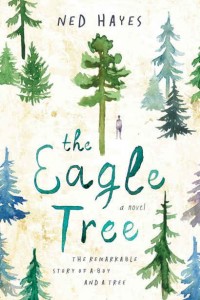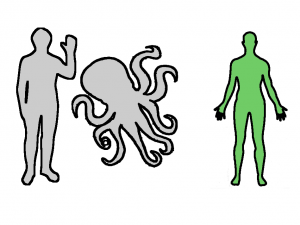 I read and loved “The Eagle Tree” by Ned Hayes, an absorbing and intense story of a boy’s love for trees and his intense fascination with the world and natural processes that surround him – an environment that, unfortunately, everyone else seems oblivious to. Amongst this natural beauty is The Eagle Tree, possibly the last Ponderosa Pine west of the Cascade Mountains. The tree can’t be saved, but perhaps it can be climbed before it is too late.
I read and loved “The Eagle Tree” by Ned Hayes, an absorbing and intense story of a boy’s love for trees and his intense fascination with the world and natural processes that surround him – an environment that, unfortunately, everyone else seems oblivious to. Amongst this natural beauty is The Eagle Tree, possibly the last Ponderosa Pine west of the Cascade Mountains. The tree can’t be saved, but perhaps it can be climbed before it is too late.
The narrative is written in what might be interpreted as the thoughts of March, who is fourteen years old and on the autistic spectrum. Ned Hayes, who has worked with children on the autistic spectrum, speaks for March, whose verbal capacity does not fully reflect his cognitive capacity or his internal thoughts. March also loses his verbal fluency when under stress and when faced by strong emotions, leading to damaging misinterpretations of his actions and intentions.
March is not portrayed as a savant and if the words in the book are taken as one possible expression of what March might have said or written himself, it is moving and lyrical. The narrative serves a similar function as the narrative constructed by the character Beth in “Love Anthony” by Lisa Genova. Her book asks and provides one possible answer to the question “What would a non-verbal 9-year-old Anthony write to his Mom?”, a letter that is heart-rendingly credible.
The essential difference
 I have referred previously (when writing about My Curious Documentary) to Olga Bogdashina’s beautiful descriptions of living in the non-verbal sensory stream in her book “Autism and the Edges of the Known World”, particularly this extract: “Yet, hard as one might try, it may be much easier for a human being with interpretation [i.e. non-autistic] to have a cultural exchange with an octopus with interpretation than it may be for a person with interpretation to comprehend someone who functions without it, primarily on the level of sensing [i.e. autistic].” (p.107, from Williams, D. (1998) Autism and Sensing: The Unlost Instinct. London: Jessica Kingsley Publishers.) There is a potential for symbolic communication between the (non-autistic) human and the (non-autistic) octopus that can not be shared with the autistic human, and conversely the non-autistic pair (having accepted intepretation and symbolic representation) are incapable of sharing the sensory world of the autistic human.
I have referred previously (when writing about My Curious Documentary) to Olga Bogdashina’s beautiful descriptions of living in the non-verbal sensory stream in her book “Autism and the Edges of the Known World”, particularly this extract: “Yet, hard as one might try, it may be much easier for a human being with interpretation [i.e. non-autistic] to have a cultural exchange with an octopus with interpretation than it may be for a person with interpretation to comprehend someone who functions without it, primarily on the level of sensing [i.e. autistic].” (p.107, from Williams, D. (1998) Autism and Sensing: The Unlost Instinct. London: Jessica Kingsley Publishers.) There is a potential for symbolic communication between the (non-autistic) human and the (non-autistic) octopus that can not be shared with the autistic human, and conversely the non-autistic pair (having accepted intepretation and symbolic representation) are incapable of sharing the sensory world of the autistic human.
The thoughts and the stream of experiences within March’s sensory world are so intense to him, but so unshareable with those around him because he lacks the language to share them. Language is, at the same time, a tyranny because to accept the verbal representation of experience is to give up the sensory qualities of experience. If I were to place an image of my favourite hot food dish in this blog post, then you might see the image and experience some version of the odours, flavours, textures and sounds of a similar experience in your life. Food (or sex) is one of very few experiences in most people’s lives that occupy all five senses simultaneously. The tree has the same impact on March, filling all his senses in a way that the non-tree people around him cannot comprehend. To accept their language would be to lose the intensity, just as I could never write down my food or sex experiences in a way that you would experience my sensory stream. At best I might manage words of a quality that evoke some similar experience of your own.
Brain pipe
March (or rather Ned Haye’s interpretation of March’s unspoken thoughts) beautifully expresses this cognitive-verbal barrier in wishing he could pipe his senses straight into other people’s brains, “Once I am at the microphone, I cannot seem to remember all of the things that I want to tell them about trees. I want to tell them everything I know about trees in the ten minutes that is all the time I will have at the microphone. I wish that I could turn a fire hose on, from my head, and I could splash water across them, and every drop of water would be full of facts that I know about the trees.”
We don’t know what such a transfer of senses would be like. We can never experience all the senses that another person experiences, although we have some idea when music or art, food or sex moves us in a similar way was we imagine that other people are moved.
How big?!
Some idea of the complexity of this inner sensory life can be seen in numerical terms by measuring the quantity of different types of information that can be conveyed by the same space. Five megabytes of a DVD film would last about 9 seconds, filling most of your visual field and both ears. Five megabytes of a CD would provide just under a minute of hi-fi stereo sound. But if we accept the tyranny of language and forego the actual visual experience (9 seconds) or actual sound experience (54 seconds) we can instead have the entire works of Shakespeare, every single creative work attributed to a lifetime, in the same five megabytes. This compression of sensory experience into shared symbols that stand for that experience is an astoundingly powerful compression mechanism. But squiggles on a page are not food, sex or trees. It is hard to imagine or share March’s sensory world, a world which he has not given up for shared language.
As March’s imagined voice says, “Sometimes I wish it was not so hard for me to make myself understood. I wish I could plug an electric cord from my brain into someone else’s ears, so that they could hear how I think and I could understand how they think. I wonder what that cord would look like. Would it be a black cord? Or a white cord?”